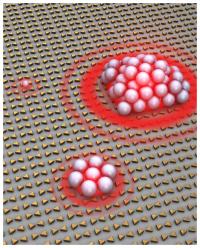Researches from the University of Illinois have discovered that the nano-scale structures facilitate smart size-sorting and optical tweezing of particles by regulating the properties of laser light illuminating arrays of metal nanoantennas.
 This is a piece of concept art depicting the various potential BNA trapping states
This is a piece of concept art depicting the various potential BNA trapping states
According to an assistant professor of mechanical science and engineering at the University of Illinois at Urbana-Champaign, Kimani Toussaint, the Nanoantennas are widely accepted due to its ability to concentrate in optical fields in small areas. Hence, for the first time, the applications of arrays of gold Bowtie nanoantenna arrays (BNAs) for manipulation of sub micrometer- to micrometer-sized objects and multipurpose optical trapping have been demonstrated. Due to the increasing interest regarding lab-on-a-chip devices, this novel technology will be more advantageous.
The researchers stated that the field confinement and enhancement properties of BNAs facilitate the operation of proficient, optical tweezers allowing high-speed manipulation of sub-micrometer to micrometer-sized objects with low-input power densities, in aqueous environments. This will benefit opto-fluidic applications such as lab-on-a-chip devices that create physics studies of colloidal dynamics, optical matter, and also formulates biological matter with condensed specimen photo damage.
The optical trapping phase diagrams provide the required trapping response. The researchers revealed various particle manipulation types, including single-beam optical tweezing of two-dimensional hexagonal packed particles over the whole nanoantenna area, optical sorting of particles by size and single-beam optical tweezing of single particles throughout the nanoantenna area, and stacking of submicron to micron-sized particles in three dimensions.
Toussaint further says that the given nanoantenna array shows a range of particle manipulation behavior for the first time. The project was supported by Gang Logan Liu of Illinois University and Nicholas Fang of MIT, besides Toussaint.